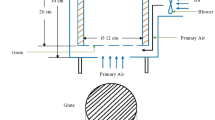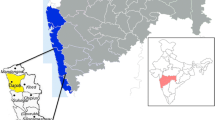Abstract
India produces 500 million metric tones of renewable agricultural biomass every year, primarily used as a cooking fuel. Inefficient combustion of biomass is one of the major hindrances for the effective utilization of this vast reserve of energy. Inefficient combustion may occur due to several factors such as lack of proper air circulation, improper packing of fuel and excess moisture content in the fuel. This paper describes the performance evaluation of three improved stoves; natural draft TLUD stove and forced draft Purti and Mpurti stove using three kinds of biomass fuel as wood chips, wood pellets and coconut shell. It was found that the thermal efficiency of the natural draft TLUD stove was 26–27%, electric fan operated Purti stove was 44–45%, and solar fan operated Mpurti stove was 46–48%. This performance was assessed by the standard laboratory-based water boiling test method (WBT) to get thermal efficiency, burning rate, boiling point, specific fuel consumption and firepower. The economic analysis study was carried out to get an idea about the approximate cost that would be incurred per month on the fuel. All these desirable parameters are maximized for the efficient combustion of fuel. The gaseous components like CO and CO2 obtained over the fuel bed are analyzed using gas chromatography. Particulate matter (PM2.5) was measured by the fine particulate sampler. PM2.5 concentration for traditional cookstoves was much higher than studied forced draft Mpurti (510 ± 45 μg/m3) and Purti stove (677 ± 40 μg/m3). The reduction in the indoor concentration of PM2.5 for Mpurti is about 60–63% as compared to traditional stove. Mean CO emissions on a volumetric basis during the cold start and hot start phase were lowest for Mpurti forced draft stove (2.41%). The study reveals that clean cooking can be achieved using the forced draft Mpurti stove.






Similar content being viewed by others
Abbreviations
- h c :
-
Thermal efficiency of the stove (%)
- Pjci :
-
Mass of container of water before test (g)
- Pj:
-
Weight of empty container (g)
- Tj:
-
Temperature of water before test (°C)
- Tjci :
-
Water temperature at start of test (°C)
- W cv :
-
Quantity of water evaporated (g)
- f cd :
-
Equivalent mass of fuel consumed (g)
- LHV:
-
Lower heating value
- SC c :
-
Specific fuel consumption (g of fuel/g of water)
- Pjcf :
-
Mass of container of water after test (g)
- T b :
-
Local boiling point of water (°C)
- ∆t s :
-
Time to boil (min)
- WP:
-
Wood pellets
- WC:
-
Wood chips
- CS:
-
Coconut shells
- FPs :
-
Fire power (Watt)
- BR:
-
Burning rate (g/min)
- WPBD:
-
Wood pellets bone dry
- CSBD:
-
Coconut shells bone dry
- WCBD:
-
Wood chips bone dry
References
Annual Book of ASTM Standard. (1983). American society for testing of materials (p. 19103). Philadelphia.
Arora, P., & Jain, S. (2016). A review of chronological development in cookstove assessment methods: Challenges and way forward. Renewable and Sustainable Energy Reviews, 55, 203–220.
Bailis, R., Berrueta, V., Chengappa, C., Dutta, K., Edwards, R., Masera, O., et al. (2007). Performance testing for monitoring improved biomass stove interventions: Experiences of the household energy and health project. Energy Sustainable Development, 11(2), 57–70.
Bhattacharya, S. C., Albina, D. O., & Khaing, A. M. (2002). Effects of selected parameters on performance and emission of biomass fired cookstoves. Biomass and Bioenergy, 23, 387.
Bocci, E. A., Sisinni, M. B., Moneti, M. C., Vecchione, L. C., Di Carlo, A. B., & Villarini, M. C. (2014). State of art of small scale biomass gasification power systems: A review of the different typologies. Energy Procedia, 45, 247–256.
Coffey, E. R., Muvandimwe, D., Hagar, Y., Wiedinmyer, C., Kanyomse, E., Piedrahita, R., et al. (2017). New emission factors and efficiencies from in-field measurements of traditional and improved cookstoves and their potential implications. Environmental Science and Technology, 51, 12508–12517.
Jetter, J., Zhao, Y., Smith, K. R., Khan, B., Yelverton, T., & DeCarlo, P. (2012). Pollutant emissions and energy efficiency under controlled conditions for household biomass cook stoves and implications for metrics useful in setting international test standards. Environmental Science and Technology, 46, 10827.
Johnson, M., Edwards, R., Frenk, C., & Masera, O. (2008). In-field greenhouse gas emissions from cookstoves in rural Mexican households. Atmospheric Environment, 42, 1206–1222.
Just, B., Rogak, S., & Kandlikar, M. (2013). Characterization of ultrafine particulate matter from traditional and improved biomass cookstoves. Environmental Science and Technology, 47, 3506–3512.
Li, W. (1994). Generalized equation for airflow resistance of bulk grains with variable density, moisture content and fines. Drying Technology, 12(3), 649–667.
Mead, D. J. (2001). The forest plantation thematic papers report plantations and wood energy (pp 5). http://www.fao.org/tempref/docrep/fao/006/ac125e/ac125e00.pdf.
Mukhopadhyay, R., Sambandam, S., Pillarisetti, A., Jack, D., Mukhopadhyay, K., & Balakrishnan, K. (2012). Cooking practices, air quality, and the acceptability of advanced cookstoves in Haryana, India: An exploratory study to inform large scale interventions. Global Health Action, 5, 19016.
Mukunda, H. S., Dasappa, S., Paul, P. J., Rajan, N. K. S., Yagnaraman, M., & Ravikumar, D. (2010). Gasifier stoves science, technology and field outreach. Current Science, 98, 627.
Prasad, K. K., Sangen, E., & Visser, P. (1985). Wood burning cookstoves. Advanced Heat Transfer, 17, 159–317.
Reed, T. B., & Larson, R. A. (1996). Wood gas stove for developing countries. In: A. V. Bridgwater (Ed.) Developments in thermo-chemical biomass conversion conference Banff, Canada (pp. 20–24). Blackie Academic Press.
Roden, A., Bond, T., Conway, S., Osorto Pinel, A., MacCarty, N., & Still, D. (2009). Laboratory and field investigations of particulate and carbon monoxide emissions from traditional and improved cookstoves. Atmospheric Environment, 43, 1170–1181.
Stahl, M., Granstrom, K., Berghel, J., & Renstrom, R. (2004). Process for biomass drying and their effects on the quality properties of wood pellets. Biomass and Bioenergy, 27, 621–628.
Still, D., MacCarty, N., Ogle, D., Bond, T., & Bryden, M. (2011). Test results of cookstove performance. Cottage Grove, OR: Aprovecho Research Center; London: Shell Foundation; Washington DC: U.S. Environmental Protection Agency.
Suresh, R., Singh, V. K., Malik, J. K., Datta, A., & Pal, R. C. (2016). Evaluation of the performance of improved biomass cooking stoves with different solid biomass fuel types. Biomass and Bioenergy, 95, 27–34.
Tryner, J., Marchese, A. J., & Willson, B. D. (2013). The effects of fuel type and geometry on emissions and efficiency of natural draft semi-gasifier biomass cookstoves. In 8th U. S. National Combustion Meeting, the University of Utah (pp 3–4).
Varunkumar, S., Rajan, N. K. S., & Mukunda, H. S. (2011a). Single particle and packed bed combustion in modern gasifier stoves—density effects. Combustion Science and Technology, 183(11), 1147–1163.
Varunkumar, S., Rajan, N. K. S., & Mukunda, H. S. (2011b). Experimental and computational studies on a gasifier based stove. Energy Conversion and Management, 53, 135.
Venkataraman, C., Habib, G., Eiguren-Fernandez, A., Miguel, A., & Friedlander, S. (2005). Residential biofuels in south Asia: carbonaceous aerosol emissions and climate impacts. Science, 307, 1454–1456.
Wendelbo, P. (2012). The Peko Pe biomass household energy program. Available at: http://wendelborecho.wordpress.com/2012/05/10/downloads. Accessed November 29, 2012.
Witt, M. J. (2005). An improved wood cookstove: Harnessing fan driven forced draft for cleaner combustion. Hartford CT: Trinity College; Cottage Grove, OR: Aprovecho Research Center.
Acknowledgements
The authors wish to acknowledge the contribution of Visvesvaraya National Institute of Technology, Nagpur, India, for providing experimental and other necessary facilities to carry out this research work.
Author information
Authors and Affiliations
Corresponding author
Rights and permissions
About this article
Cite this article
Sonarkar, P.R., Chaurasia, A.S. Thermal performance of three improved biomass-fired cookstoves using fuel wood, wood pellets and coconut shell. Environ Dev Sustain 21, 1429–1449 (2019). https://doi.org/10.1007/s10668-018-0096-0
Received:
Accepted:
Published:
Issue Date:
DOI: https://doi.org/10.1007/s10668-018-0096-0




